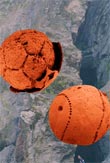
The discovery of spherical fossils that resemble tiny baseballs could reveal how the earliest known egg-laying organism developed from embryo to adulthood.
In 1998, researchers discovered thousands of 600-million-year-old fossilized embryos in the Doushantuo Formation, a fossil deposit in South China. Two years later, the same team unearthed fossils of a tubular coral-like animal, called Megasphaera ornata, which appeared to be grown-up versions of the embryos discovered earlier.
The case for a relationship between the two fossil types now has been strengthened by the recent discovery of about 80 intermediate-stage fossils that have traits in common with both groups.
The finding, to be detailed in the February issue of the journal Geology, could provide the missing link between egg and adult versions of one of Earth’s earliest animals.
Outward appearance
Externally, the early and intermediate stage embryos appear very similar. They are about the same size—about 0.02 inches wide or about as big as a grain of sand—and both have similar outer coverings, called embryonic envelopes.
It’s inside that the real differences become apparent. Using an imaging technique called microfocus X-ray computed tomography (microCT), the researchers virtually peeled away the envelope to reveal the new fossils’ insides.
Get the world’s most fascinating discoveries delivered straight to your inbox.
Inside, they found three-dimensional spiral structures that look like grooves on a screw.
The only signs of these coils on the outside of the embryos are tiny holes arranged in a pattern resembling stitches on a baseball [image]. Traces of these coils are also found on the external coverings of the adult fossils.
Some of the intermediate embryos also appeared to be unfurling; the researchers speculate that if the process had continued, the embryos would distend like a stretched slinky or a flattened fuselli noodle into the tubular adult form.
“The new fossils provide some suggestive evidence that these two groups of fossils are linked developmentally,” said study team member Shuhai Xiao of Virginia Tech.
Growth steps
The new embryos could help shed light on how ancient animals developed and whether the process was similar to that of living organisms. Ancient embryos and embryos from modern day animals are remarkably similar, but the developmental journey from egg to adult for ancient organisms is still shrouded in mystery.
“Now we have isolated dots. We need to connect them and make a complete story before we can say anything about their evolutionary relationship,” Xiao told LiveScience.
The researchers are hopeful that they can find later stages of embryo development for M. ornata. “I think this is an encouraging sign that later embryonic stages may still be preserved in this rock,” Xiao said. “If we keep looking, we may even find a developmental sequence.”
- Life's Little Mysteries
- Fossils Never Looked So Good
- Ancient Fossilized Embryos Imaged in 3D
- Dinosaur Embryos Reveal 'Ridiculous' Proportions
- Rare Discovery: Fossilized Bone Marrow is 10 Million Years Old
- The Biggest Popular Myths


